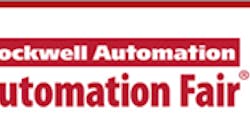In the past, original equipment manufacturers (OEMs) often found themselves competing on price. Those days are long gone. Customers have driven machine builders to create a value proposition that differentiates them from competitors by addressing the specific needs of the end user.
A food processor, for example, might be focused on energy efficiency or water usage. Being able to help that end user to not only conserve the use of water, but monitor and optimize the discharge of wastewater, is a value-added strategic differentiator, according to Greg Turner, global OEM segment business manager, process, Rockwell Automation, in an interview this week at the company's Automation Fair event in Chicago.
"OEMs now want help with creating value-add, not just making machines cheaper," he said.
One of the differentiating features that an OEM can offer to the end user is the ability to provide data in the form of the business KPIs the user is targeting, such as overall equipment effectiveness (OEE) or total cost of ownership (TCO).
"We might be talking about different library objects that will go into a controller and allow the OEM to pull all kinds of data from the machine," explained Turner. "The OEM is serving up that key data to the end user for the enterprise data system. The end user might have a goal to reduce energy consumption by 2%. You can set the goal and then measure against it."
Smart machines in action
"OEMs now wants help with creating value-add, not just making machines cheaper."
Greg Turner of Rockwell Automation explained how machine builders can monetize smart-machine technology at Automation Fair 2015.
By way of example, Turner described a cheese manufacturer and packaging OEM that together benefitted from embedded Rockwell Automation capabilities. Tight control of final packaged product weight was critical: underweight packages incurred regulatory penalties, and overweight packages resulted in product giveaway as well as incremental taxes. Being able to monitor and control that weight was critical to profitability.
"The OEM could log all of the data needed to help the end user, but it still had to be able to get that data from the machines," said Turner. "Our products provide that ability. We focus on EtherNet/IP, which has a lot of advantages, and we provide the kinds of libraries that can be used to reduce development time for the OEM."
INCO Engineering in the Czech Republic designs and builds hoists and systems for vertical and inclined transport in mines around the globe. Capacity and performance requirements vary based on customer needs, but the two constants are safety and reliability. To mitigate downtime risk, INCO builds three layers of control redundancy into each system.
Further, it continuously monitors conditions of selected equipment at the company's central service center. If an issue occurs, INCO staff can notify its customers immediately. Staff can also analyze the most frequent faults and help users make equipment and process adjustments to prevent further occurrences.
Implementation strategy
Enabling manufacturing machinery with Industrial Internet-of-Things (IIOT) technology is a step-by-step process. Legacy equipment exists and might not be scheduled for replacement or upgrade for years, but including IIoT capabilities on new machinery gives customers the ability to simply turn it on when they're ready. The communications protocol can be a good place to start preparing.
"We provide controls and automation, and we partner with Endress+Hauser for instrumentation," explained Turner. "We build and propose solutions for all of our components—PLCs, I/Os, drives—which are all enabled for IIoT with EnterNet/IP, which can feed ERP or MES directly," Turner said. "In the interim, if you have other protocols such as Profibus, you probably will have to go through some converter."
Controllers can be a simple initial step. "Smaller-memory and smaller-footprint controllers in the OEM space can be much more cost-competitive," explained Turner. "An OEM might find that a full ControlLogix PLC is too much, so we might advise a CompactLogix instead. It's got an advantage in cost and footprint but uses the same protocol. It's all standardized."
OEMs needn't worry about the increased cost of adding IIoT technology on machines, Turner added. "The cost is not excessive, and there's a huge mitigating factor. We build tools for our hardware, such as OEM library objects, that reduce development time. For drives, we feature Premier Integration, which saves on implementation effort."
"These sorts of toolsets reduce development, design and delivery time, and for OEMs can mean higher margins or lower prices they can pass on to the end user."
In everything Rockwell Automation develops for smart machines, nothing is developed without an associated value proposition, said Turner. "I try to get OEMs to take on newer technology in what they're designing because it will give them a competitive advantage," he explained. "It will improve business, whether that's reducing development time or enabling remote monitoring. Smart machines offer the ability to take production-specific data from the machine and convert it to business analytics."





